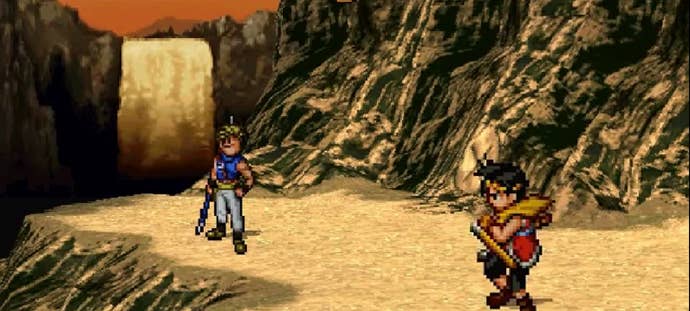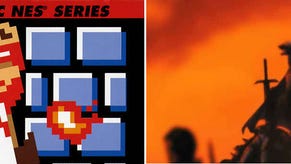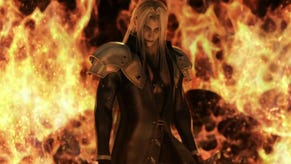USgamer Club: Suikoden II Part 3 — Fin
Kat finishes her examination of Suikoden II by taking a look at its conclusion.
This article first appeared on USgamer, a partner publication of VG247. Some content, such as this article, has been migrated to VG247 for posterity after USgamer's closure - but it has not been edited or further vetted by the VG247 team.
With Suikoden II wrapping up this week, Bob will be leading a USgamer Club for The Legend of Zelda: Majora's Mask next week. Play up through the end of the first dungeon and join him! While you're at it, send your thoughts to bob.mackey@usgamer.net on the following question: What do you think of Termina compared to other Legend of Zelda settings? How are you dealing with the restrictions Majora's Mask places on the player? And what subtle character moments have you witnessed simply by talking to people at different parts of the three-day cycle? We'll post our favorite responses in next week's article.
Note: This discussion of Suikoden II includes spoilers.
No matter what, history marches on. Great victories fade, new challenges arise, and we are forced to re-learn the lessons that we thought had become ingrained in the last conflict. And so Suikoden II's main character does the only thing he can to escape the cycle: He walks away. At least he does if you get the good ending.
I did not get that ending. In my hurry to finish Suikoden II, I missed out on several members of the 108 Stars of Destiny, most of whom are difficult to impossible to find without some sort of comprehensive guide. As such, when the crucial moment came, Jowy and Nanami died while the main character rose to the throne, permanently trapping him in the crucible of history. It's a happy ending insofar as the hero proves to be a good ruler and peace is obtained for a while, but the shot of him silently watching the setting sun says all that needs to be said. In the name of peace, the main character ends up sacrificing his youth, his freedom, and his friends.
On the other hand, if you successfully obtain all recruitable characters and fulfill certain requirements, Nanami and Jowy end up living, and the three main characters retire to a house in the country with Pilika to happily live out their days. The implication is that all goes well and peace is maintained. But if a new threat arises, as will inevitably happen, then someone else will have to deal with it.
My first reaction upon seeing Suikoden II's "real" conclusion was to feel as if the hero was shirking his duty in some way, and that it was actually better for him to take the throne, since he's shown to be the best person for the job. But as Shu says in his final scene, the hero has done his part in reunited the City-State of Jowston. He is free to go his own way and allow the grind of history to continue without him. In so doing, he seemingly obtains true happiness, with his only note in the epilogue being, "To him, the smiles of Jowy and Nami are his greatest treasures."

The main character's decision reminds me a bit of an ongoing disagreement in the excellent Mission Log podcast, in which the hosts argue whether Captain Kirk is right to go around insisting that societies have to continue evolving, or if its okay for them to settle down and be content with what they have. Suikoden II seems to fall on the latter side of the argument by supporting the main character's quest for peace and happiness at the expense of growth and power. You could say it's the opposite of Game of Thrones, where those who don't seek power usually end up being destroyed by it.
Ultimately, both endings serve as a graceful conclusion to Suikoden II's well-crafted story. I've wondered in the past whether RPGs need good stories to be successful; and for the record, I still believe they don't. But a strong story can nevertheless elevate an RPG from good to great, taking the burden off the systems and making it a compulsive play. Suikoden II is pretty much the epitome of that story-first approach to roleplaying design.
So if you haven't gotten around to Suikoden II yet, then you might want to stop what you're doing and get on that. It's even worth skipping the first Suikoden and just going right to the sequel—what you'll miss in callbacks and continuity nods you'll gain in cutting right to the chase and playing the superior game.
It's a shame that it's taken this long for such an essential part of the RPG canon to become widely available. But now that it is, it shouldn't be missed.

The Community Speaks
These are a few of the most interesting comments from last week's installment of the USgamer Club.
SatelliteOfLove:. I've always said that Suikoden 1 & 2's battle system was a simple strength; outside of boss fights, ya in ya out, ya in ya out. It looks even BETTER in comparison to simple-and-easy-yet-fiddly-and-time-devouring games that came out around that time like FF IX and Legend of Dragoon
A strong point, and I agree. You can find some extended thoughts on the battle system below, but it definitely stands out in comparison with its contemporaries, which tend to be ponderous and bloated. Even Final Fantasy X, which is notably speedier than its predecessors, feels sluggish in comparison to Suikoden II. For that reason, Suikoden tends to hold up much better than other PlayStation RPGs.
StevieWhite: I always thought [Neclord] as more of a callback to Suikoden I for returning fans (which Suikoden II does far more openly and blatantly than any other game in the series). It does reek of padding, though, now that I think of it - there's really no reason for Neclord to come back in this game. But hey, I guess we do get a neat vampire hunter character out of it.
Neclord also plays more of a role after Luca goes down, as I expected. He's still a bit of a sideshow, but he's a useful illustration of the fact that while Magical Hitler is dead and buried, evil lives on. And with his plans to build a zombie army and go full Walking Dead on the City-State, Neclord is evil indeed.
franciscovillarrealh:I love how the gameplay serves the story on this part: you have Jowy with you mostly from the start, flour run notwithstanding, and have access to a very useful crowd-clearing Unite attack. Then you get your True Rune halves and a filler dungeon to try them out, after which you feel pretty confident you can handle anything the game throws at you!
Then Jowy kills Annabelle and leaves the party. Your character is reeling from the betrayal and in the event that the player isn't engaged in the plot to feel that right along, the loss of both the Unite and the Black Sword Rune will make this sting. Also, just to drive the point home, you lose access to most of your party until after clearing out North Window, having to make do with an okay-ish mage (Eilie), a crutch character you're starting to catch up to (Viktor) and a mediocre newbie (Freed).
But hey, you think, the Hero still has the Bright Shield Rune, right? At level 20-something, that should give you enough charges to breeze through things until you can properly build a party again!
No, says the game, because now the bosses attack twice per turn! In fact, some of them can attack three times! What, did you think Konami wouldn't take into account the main character having a powerful healing rune for most of the game?
And that, folks, is good RPG design.
Stray Thoughts

Jowy acknowledges his crimes in Suikoden II's final scenes, but the story is perhaps a little too forgiving of his sins. I suppose that his penance is dying so that the hero might unite the kingdom, but that's the normal ending. The best ending sees him full redeemed and happily traveling with the hero and Nanami. In an otherwise strong story, it's just a bit too neat. I'd be interested to hear the thoughts of the community on this one.






